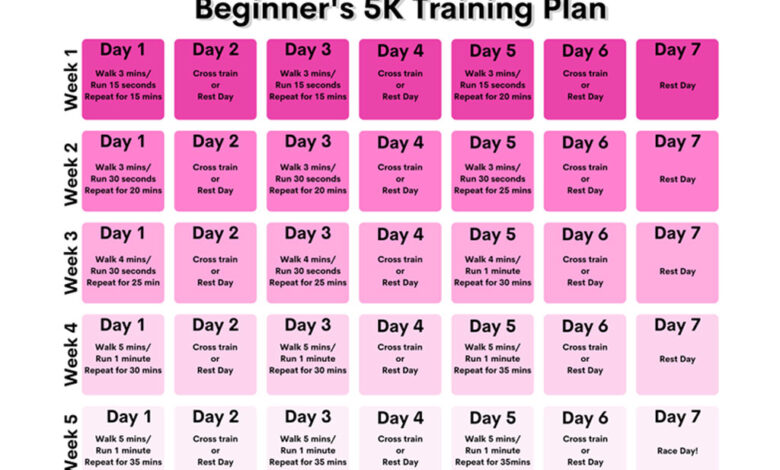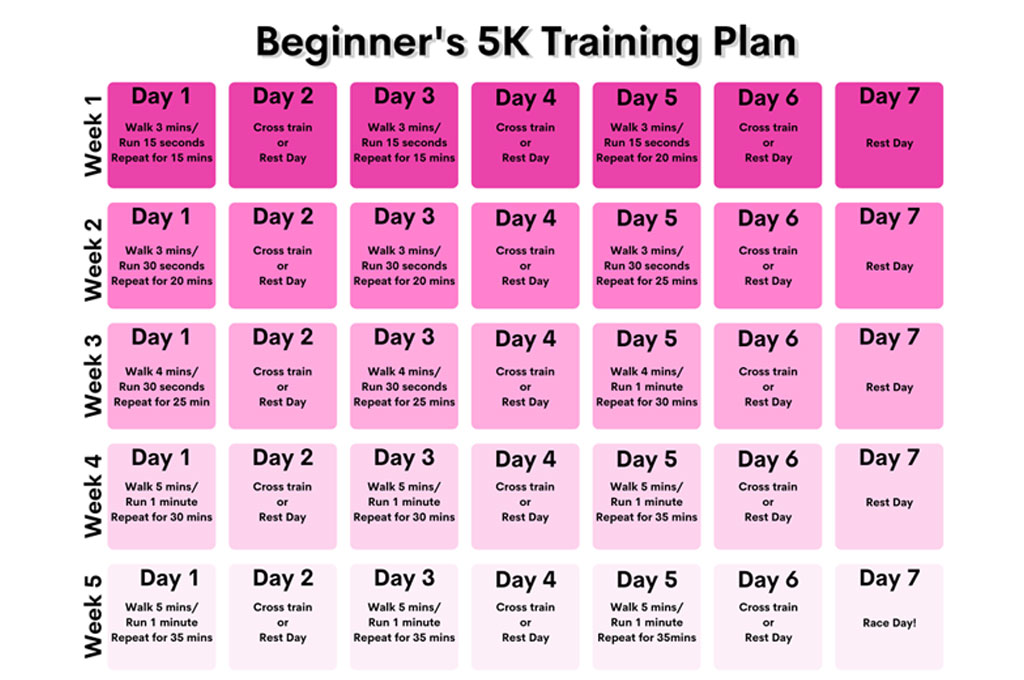
Your Guide to Doubling Your 5K Walk to a 10K
Your guide to doubling your 5K walk to a 10K is here, and it’s time to lace up your shoes and embark on a journey to conquer the 10K distance. This guide will take you through a comprehensive training plan, covering everything from gradual mileage increases to proper nutrition and mental preparation.
We’ll explore different training methods, address common challenges, and provide you with the tools and strategies to make your 10K dream a reality. So, whether you’re a seasoned walker or a beginner looking to push your limits, let’s get started on this exciting adventure!
Imagine yourself crossing the finish line of a 10K, feeling accomplished and proud of your achievement. This guide will help you get there, step by step. We’ll break down the journey into manageable chunks, ensuring you stay motivated and injury-free.
From understanding the importance of rest days to mastering the art of pacing yourself during the race, we’ll cover every aspect of your training. Ready to double your distance and embrace the challenge? Let’s dive in!
The Journey to 10K
Congratulations on completing your first 5K! Now, you’re ready to take on the challenge of doubling your distance to 10K. This journey requires patience, consistency, and a smart training plan. Rushing into longer distances without proper preparation can lead to injuries and setbacks.
Gradual Increase in Distance
Increasing your mileage gradually is crucial for avoiding injuries and ensuring your body adapts to the increased workload. A sudden jump in distance can put excessive stress on your muscles, tendons, and joints, leading to overuse injuries.
Training Timeline
Here’s a sample timeline for increasing your mileage, allowing for rest days and recovery:
Week 1
- Monday: Rest
- Tuesday: 5K walk
- Wednesday: Rest
- Thursday: 3K walk
- Friday: Rest
- Saturday: 5K walk
- Sunday: Rest
Week 2
- Monday: Rest
- Tuesday: 5K walk
- Wednesday: Rest
- Thursday: 4K walk
- Friday: Rest
- Saturday: 6K walk
- Sunday: Rest
Week 3
- Monday: Rest
- Tuesday: 6K walk
- Wednesday: Rest
- Thursday: 5K walk
- Friday: Rest
- Saturday: 7K walk
- Sunday: Rest
Week 4
- Monday: Rest
- Tuesday: 7K walk
- Wednesday: Rest
- Thursday: 6K walk
- Friday: Rest
- Saturday: 8K walk
- Sunday: Rest
Week 5
- Monday: Rest
- Tuesday: 8K walk
- Wednesday: Rest
- Thursday: 7K walk
- Friday: Rest
- Saturday: 9K walk
- Sunday: Rest
Week 6
- Monday: Rest
- Tuesday: 9K walk
- Wednesday: Rest
- Thursday: 8K walk
- Friday: Rest
- Saturday: 10K walk
- Sunday: Rest
This timeline is just a suggestion. Adjust it based on your individual fitness level and how your body responds to training. Listen to your body and don’t hesitate to take extra rest days if needed.
Preventing Injuries
Avoiding injuries is paramount during your training. Here are some tips to keep you safe:
- Proper Warm-up and Cool-down:Before each walk, spend 5-10 minutes warming up with light cardio and dynamic stretches. After your walk, cool down with static stretches for 5-10 minutes.
- Listen to Your Body:Pay attention to any pain or discomfort. If you experience sharp or persistent pain, stop walking and consult a doctor.
- Proper Footwear:Wear well-fitting, supportive shoes designed for walking.
- Gradual Increase in Intensity:Don’t increase your pace or distance too quickly. Allow your body to adapt gradually.
- Cross-Training:Engage in other activities like swimming or cycling to work different muscle groups and prevent overuse injuries.
- Hydration:Drink plenty of water before, during, and after your walks.
- Nutrition:Eat a balanced diet rich in fruits, vegetables, and whole grains to fuel your body and support recovery.
“Consistency is key to success. Stick to your training plan, listen to your body, and you’ll be well on your way to completing your first 10K walk.”
Training Strategies for Doubling Your Distance

Congratulations on making the decision to double your 5K walk to a 10K! It’s a fantastic goal, and with the right training plan, you can achieve it. To successfully transition from a 5K to a 10K, you’ll need to gradually increase your distance and build endurance.
This involves incorporating various training methods into your routine.
Interval Training
Interval training is an effective way to improve your speed and endurance. This method involves alternating between periods of high-intensity effort and rest or low-intensity recovery. For example, you could walk at a brisk pace for 5 minutes, followed by 2 minutes of walking at a slower pace.
Repeat this cycle for a set number of times. The benefits of interval training include:
- Improved cardiovascular fitness
- Increased speed and endurance
- Enhanced fat burning
- Increased motivation due to the variety of the workout
However, interval training can be demanding on your body, and it’s important to listen to your body and rest when needed.
Tempo Runs
Tempo runs are a type of training that focuses on maintaining a consistent pace for a sustained period. This pace is usually faster than your comfortable walking pace but slower than your sprint pace. A tempo run could involve walking for 20-30 minutes at a steady pace that you could sustain for an extended period.The benefits of tempo runs include:
- Improved lactate threshold, which is the point at which your body starts to produce lactic acid
- Increased endurance
- Improved running economy
Tempo runs can be challenging, so it’s essential to start slowly and gradually increase your distance and pace over time.
Long Slow Runs
Long slow runs (LSRs) are the cornerstone of endurance training. These runs are performed at a comfortable pace that you can sustain for an extended period. The goal of LSRs is to build endurance and train your body to handle longer distances.
The benefits of LSRs include:
- Increased endurance
- Improved cardiovascular fitness
- Enhanced fat burning
The key to LSRs is consistency. It’s essential to gradually increase your distance over time, starting with shorter distances and gradually working your way up to your target distance.
Doubling your 5k walk to a 10k is a fantastic goal! It’s a big step, but with consistent training and the right mindset, you can definitely do it. One key element is fueling your body with nutritious foods, which can sometimes be a challenge.
That’s where learning to love or like eating healthy comes in – check out this article for some helpful tips: ways to learn to love or like eating healthy. Once you’ve got the nutrition down, you’ll be amazed at how much easier it is to conquer those extra miles!
Sample Training Plan
Here is a sample training plan that incorporates all three training methods:
| Day | Workout | Duration |
|---|---|---|
| Monday | Rest or light activity | – |
| Tuesday | Interval training | 30 minutes |
| Wednesday | Tempo run | 30 minutes |
| Thursday | Rest or light activity | – |
| Friday | Long slow run | 45-60 minutes |
| Saturday | Rest or light activity | – |
| Sunday | Long slow run | 60-90 minutes |
This is just a sample plan, and you may need to adjust it based on your fitness level and goals.
So you’re ready to double your 5k walk to a 10k? Awesome! To fuel your journey, I’ve been experimenting with a Mediterranean diet approach, and I’ve found some great tips on ways to make the Mediterranean diet low carb friendly that have helped me stay energized and focused.
With the right nutrition, I’m confident you can hit that 10k goal and feel amazing doing it!
Remember to listen to your body and take rest days when needed.
Ready to double your 5k walk to a 10k? It’s a fantastic goal, but sometimes it’s easy to let those training days slip by. If you find yourself hitting the snooze button instead of hitting the pavement, check out these 5 tips squashing procrastination to help you stay on track.
Once you’ve mastered those, you’ll be well on your way to conquering that 10k!
Nutrition and Hydration for a 10K
Fueling your body with the right nutrition and staying hydrated is crucial for endurance running. Proper nutrition and hydration can improve your performance, prevent injuries, and help you feel your best during and after your run.
Pre-Race Nutrition
A well-balanced diet in the days leading up to your 10K is essential. This means consuming a variety of foods from all food groups, including fruits, vegetables, whole grains, lean protein, and healthy fats. Here’s a sample meal plan for the days leading up to your 10K:
Sample Meal Plan
- Day Before:
- Breakfast:Oatmeal with berries and nuts
- Lunch:Grilled chicken salad with whole-wheat bread
- Dinner:Salmon with roasted vegetables and quinoa
- Race Day:
- Breakfast:Toast with peanut butter and banana
- Pre-Race Snack:Energy bar or fruit
Hydration During and After the Run
Staying hydrated is vital during and after your run. Water is the primary source of hydration, and it’s important to drink enough before, during, and after your 10K.
Hydration Recommendations
- Before the Run:Drink plenty of water in the days leading up to your race, and start hydrating a few hours before your run.
- During the Run:Drink water or sports drinks every 20-30 minutes. Sports drinks can provide electrolytes that are lost through sweat.
- After the Run:Continue to drink water and sports drinks to replenish lost fluids and electrolytes.
Mental Preparation for a 10K: Your Guide To Doubling Your 5k Walk To A 10k
Doubling your distance from a 5K to a 10K requires more than just physical training; it demands mental fortitude and a strong mindset. This journey will test your limits and challenge your perceptions of what you’re capable of. Mastering your mental game is crucial for success, helping you overcome obstacles and achieve your goals.
Strategies for Overcoming Mental Barriers
Mental barriers are common during long runs, but with the right strategies, you can break through them. One effective technique is to break down the distance into smaller, more manageable chunks. Instead of focusing on the entire 10K, concentrate on completing each mile or kilometer.
This approach makes the run feel less daunting and helps you stay motivated. Another helpful strategy is to visualize your success. Before your run, spend a few minutes picturing yourself completing the 10K strong and confident. This visualization can help build your mental resilience and prepare you for the challenges ahead.
Common Mental Challenges and Solutions
- Doubt and Fear:Doubting your abilities or fearing failure is common, especially when pushing your limits. Combat these negative thoughts by focusing on your progress and celebrating your achievements, no matter how small. Remind yourself of the reasons you started this journey and visualize your success.
- Boredom and Fatigue:Long runs can be monotonous, leading to boredom and fatigue. To combat this, try listening to music or podcasts, engaging in conversation with a running buddy, or exploring new routes. These distractions can help you stay engaged and focused.
- Pain and Discomfort:Pain and discomfort are inevitable during long runs. Acknowledge these sensations, but don’t let them dictate your performance. Use positive self-talk to remind yourself that pain is temporary and that you are capable of pushing through it.
Tips for Staying Motivated and Focused, Your guide to doubling your 5k walk to a 10k
- Set Realistic Goals:Setting achievable goals can help you stay motivated and prevent discouragement. Break down your training plan into smaller, more manageable goals, and celebrate each milestone you reach.
- Find a Running Buddy:Having a running buddy can provide support, motivation, and accountability. Sharing your goals and experiences with someone else can help you stay committed to your training.
- Reward Yourself:Rewarding yourself for achieving your goals can help you stay motivated and on track. This could be anything from buying yourself a new pair of running shoes to enjoying a special meal after a successful run.
Race Day Essentials

Race day is finally here! All your hard work and dedication have led you to this moment. Now, it’s time to focus on a few key essentials to ensure a successful and enjoyable 10K experience. A well-prepared race day can make a significant difference in your performance and overall enjoyment.
Race Day Checklist
A well-organized checklist can help you avoid last-minute stress and ensure you have everything you need.
- Running Shoes:Your trusty running shoes are your most important piece of gear. Ensure they are comfortable and well-broken in.
- Running Apparel:Choose breathable and moisture-wicking clothing that allows for good ventilation. Consider the weather conditions and dress accordingly.
- Race Bib:This is essential for identification and tracking. Pin it securely to the front of your shirt.
- Hydration Belt or Water Bottle:Carry a hydration belt or water bottle to stay hydrated during the race.
- Energy Gels or Chews:If you plan to use energy gels or chews, pack them in your belt or pockets.
- Watch or GPS Device:A watch or GPS device can help you track your pace, distance, and time.
- Sunscreen and Hat:Protect yourself from the sun with sunscreen and a hat, especially if the race is held on a sunny day.
- Extra Layers:Pack an extra layer of clothing for warmth, especially if the weather is unpredictable.
- Cash or Credit Card:Bring some cash or a credit card for purchasing snacks or drinks after the race.
- Emergency Contact Information:Carry emergency contact information in case of an unexpected situation.
Warm-up and Cool-down
Proper warm-up and cool-down routines are crucial for preventing injuries and optimizing your performance.
- Warm-up:A dynamic warm-up prepares your muscles for the demands of running. This can include light jogging, dynamic stretching (such as arm circles, leg swings, and torso twists), and some light drills (such as high knees and butt kicks).
- Cool-down:A cool-down helps your body recover and prevents muscle soreness. It typically involves light jogging followed by static stretching (holding each stretch for 15-30 seconds).
Pacing Strategies
Pacing is essential for maintaining a consistent effort throughout the race and preventing burnout.
- Start Slowly:Resist the temptation to start too fast. Begin at a comfortable pace that you can sustain for the entire race.
- Negative Split:A negative split strategy involves running the second half of the race faster than the first half. This can be effective if you feel strong and have enough energy to push towards the end.
- Use Landmarks:Use landmarks along the course to gauge your progress and adjust your pace accordingly.
- Listen to Your Body:Pay attention to your body’s signals. If you start feeling tired or uncomfortable, slow down or take a short break.
Closing Notes

Congratulations! You’ve reached the end of this guide, and now you’re equipped with the knowledge and strategies to successfully double your 5K walk to a 10K. Remember, consistency is key. Stick to your training plan, listen to your body, and celebrate your progress along the way.
The journey is just as rewarding as the destination. Embrace the challenge, push your limits, and enjoy the incredible feeling of achieving your goal! You’ve got this!






